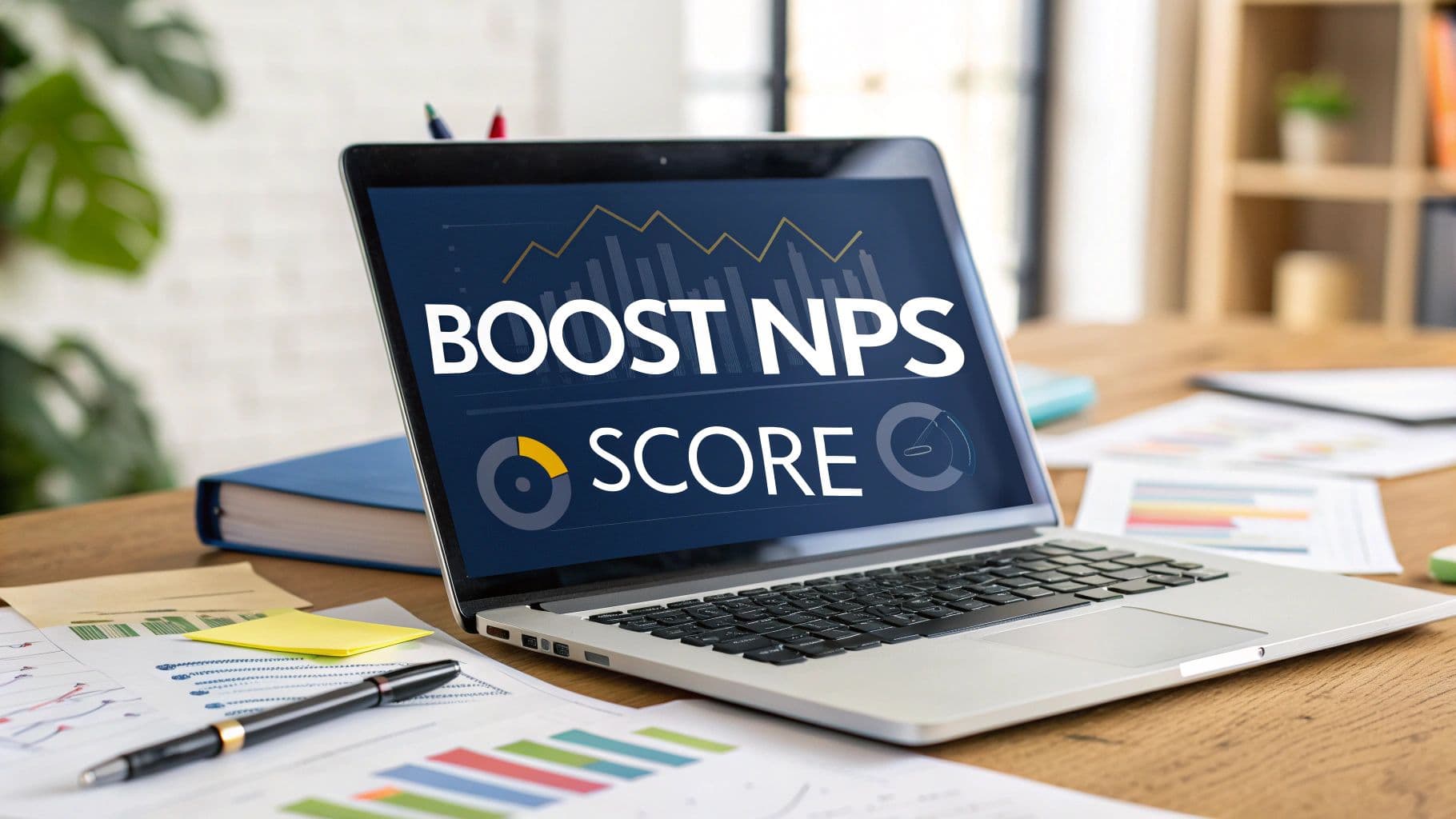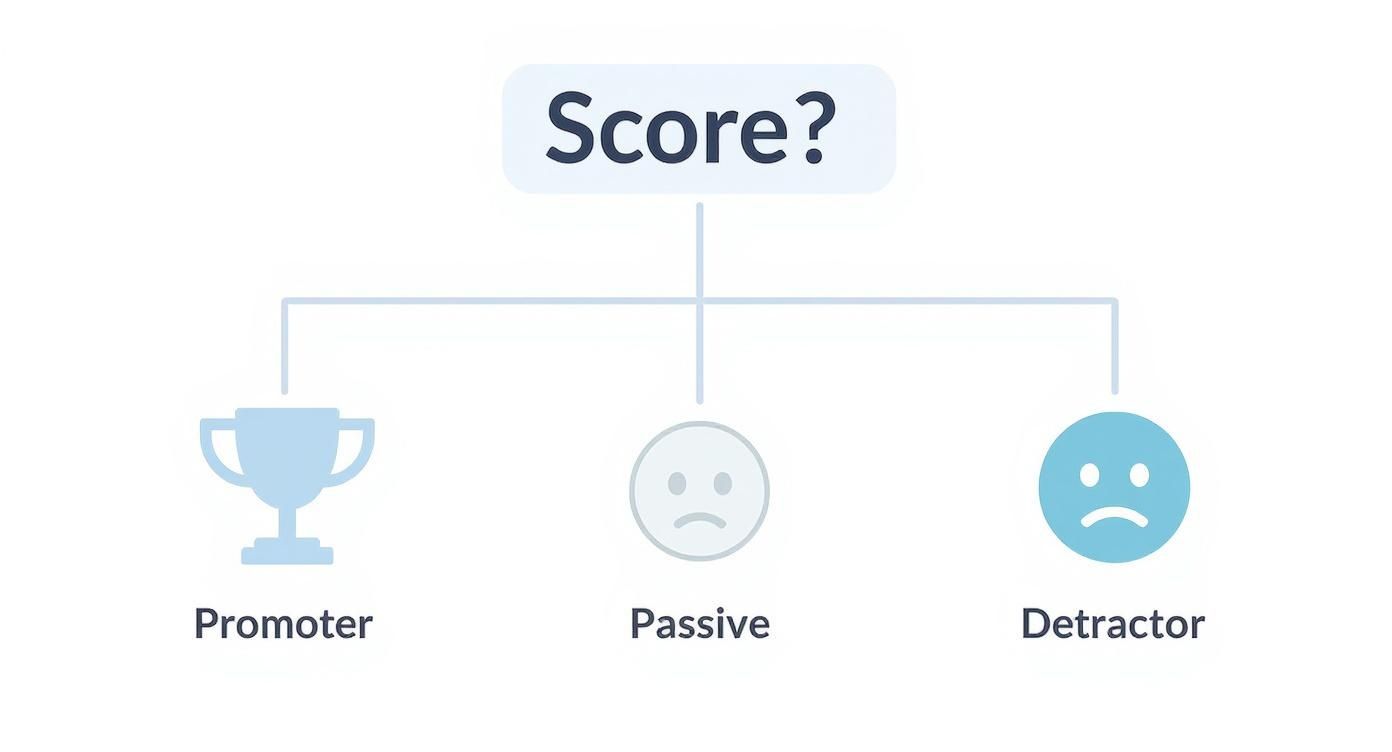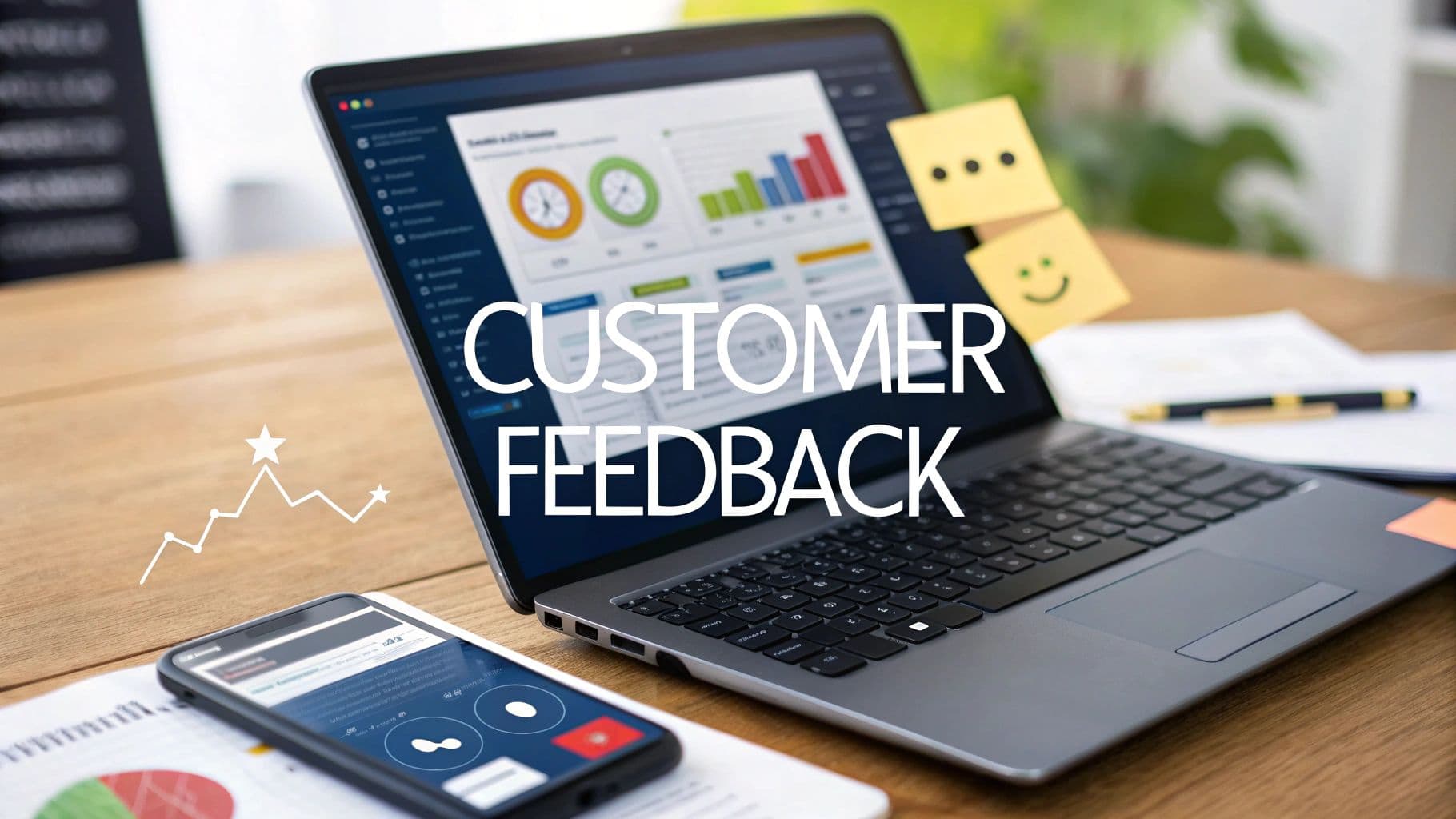How to Improve NPS Scores and Boost Customer Loyalty
Discover how to improve NPS scores with this practical guide. Learn to design effective surveys, analyze feedback, and close the loop to build lasting loyalty.

Getting your NPS score to climb isn't about one magic trick. It's about building a solid system: designing smarter surveys, digging deep into the feedback you get, personally following up with customers, and weaving those insights into the very fabric of your company. This is how you turn a simple number into a real engine for growth that’s fueled by your customers.
Building Your Foundation for NPS Improvement

Before you can start chasing a higher number, you need to get the fundamentals right. A strong Net Promoter Score is so much more than a vanity metric. It’s a direct pulse on customer loyalty and a surprisingly accurate predictor of your future revenue. It tells you, in no uncertain terms, whether you're creating enthusiastic advocates or leaving a wake of unhappy detractors.
To get started on the right foot, it’s worth spending time understanding key customer satisfaction measurement methods like NPS and what makes it tick. Why? Because NPS isn't just about the score itself—it's about the entire system you build around it to listen and respond.
Your NPS Improvement Framework at a Glance
A solid NPS program is built on four core pillars. They all work together to create a cycle of continuous improvement. If you neglect one, the whole system can grind to a halt. This table breaks down the essentials.
| Pillar | Key Action | Expected Outcome |
|---|---|---|
| Survey Design | Crafting clear, well-timed questions that capture useful feedback without annoying customers. | Higher response rates and more actionable, specific feedback. |
| Feedback Analysis | Segmenting responses by customer type, lifecycle stage, or product usage to spot hidden trends. | Deeper insights into why customers feel the way they do, beyond the score. |
| Closing the Loop | Creating a repeatable process for following up with promoters, passives, and especially detractors. | Reduced churn, increased loyalty, and customers who feel heard and valued. |
| Operational Integration | Making customer feedback a shared, visible priority across all teams—not just a support metric. | A customer-centric culture where product, marketing, and sales are all aligned. |
This isn't just theory. It's the playbook that separates fast-growing companies from everyone else.
The Core Pillars of an Effective NPS Program
Let's dig a little deeper into what these pillars look like in practice. Your immediate action plan should be built around these four areas:
- Smarter Survey Design: Think less about just asking the question and more about when and how. The best surveys are concise, clear, and perfectly timed to capture feedback when it’s most relevant, avoiding the dreaded survey fatigue.
- Deep Feedback Analysis: The real gold isn't in the raw score. It’s in the comments. You need to slice and dice the data by customer segments—like new vs. long-term users, or enterprise vs. SMB clients—to uncover those "aha!" moments.
- Airtight "Closing the Loop" Process: This is non-negotiable. You must have a clear plan for following up with every respondent. Thank your Promoters, engage your Passives, and—most importantly—reach out to your Detractors to understand their pain points and show you’re committed to making things right.
- Full Operational Integration: Customer feedback can't live in a silo. It needs to be a visible, shared responsibility. When your product team sees what frustrates users and your marketing team knows what your biggest fans love, real change starts to happen.
The data backs this up. Research from Bain & Company, the creators of NPS, shows that companies who master this system tend to grow at more than twice the rate of their competitors. This directly links a well-run NPS program to real, tangible business results.
Ultimately, a weak foundation will limit how high your score can go. A thoughtful strategy ensures every action you take is purposeful and contributes to building lasting loyalty. It's a commitment to a customer-first mindset that should influence everything from product roadmaps to marketing campaigns. For a deeper look at this, you can explore other https://www.sigos.io/blog/client-satisfaction-metrics that complement NPS and drive business success.
Designing NPS Surveys That Actually Get Real Answers

Let's be honest: the insights you get are only as good as the questions you ask. If you're just blasting out the standard "how likely are you to recommend" question into the void, you're missing the point. The real magic is in how you design the survey—its timing, wording, and the channel you use.
A poorly timed or generic survey is easy to ignore, and you end up with skewed data from only your most vocal customers. The goal is to make your feedback request feel less like a transaction and more like a genuine check-in. This small shift in perspective can massively boost your response rates and unearth the kind of feedback you can actually use to improve your NPS scores.
Timing Is Everything
Sending an NPS survey at just the right moment is key to capturing honest, in-the-moment sentiment. If you wait a month after a purchase, you might get feedback on the product's durability, but you'll completely miss their thoughts on the initial onboarding or delivery experience. Every touchpoint is a unique window into their journey.
Think about these real-world scenarios for timing your surveys:
- Post-Purchase: I've found that sending a survey 7-10 days after a physical product arrives or a SaaS subscription starts is the sweet spot. It gives them enough time to form an impression but keeps the experience fresh in their mind.
- After a Support Interaction: You want to trigger a survey within 24 hours of closing a support ticket. This gives you direct, unfiltered feedback on how your customer service team is performing.
- Following a Key Feature Use: For software, try sending a survey right after a customer uses a critical feature for the first time. This is a great way to find out if your core value proposition is actually hitting the mark.
The Power of the Open-Ended Follow-Up
The 0-10 rating tells you what a customer feels. The gold is in understanding why. This is where a single, well-phrased open-ended question becomes your most valuable tool. It unlocks the context behind the number, revealing specific pain points or moments of pure delight.
But please, avoid lazy follow-ups like "Any other comments?" Instead, tailor the question to the score they just gave you:
- For Promoters (9-10): "We're thrilled you feel that way! What was the main reason you gave that score?" This helps you pinpoint what you're doing right so you can do more of it.
- For Passives (7-8): "Thanks for your feedback. What's one thing we could do to improve your experience?" This question is neutral and prompts constructive, specific ideas.
- For Detractors (0-6): "We're sorry we didn't meet your expectations. Could you tell us more about what happened?" This shows you're actually listening and ready to fix the problem.
These targeted questions prove you're paying attention, which encourages a much more thoughtful response. Frankly, this qualitative data is often where the most actionable improvement ideas come from.
Deploying Surveys Across the Right Channels
Where you ask for feedback matters just as much as what you ask. To get the best response rates, you have to meet your customers where they already are. If you're only relying on email, I guarantee you're missing a huge chunk of your audience.
Here’s a quick breakdown of the channels I see work best:
| Channel | Best For | My Pro Tip |
|---|---|---|
| Getting detailed feedback from established, engaged customers. | Always personalize the subject line with their first name. It's a small thing that makes a big difference in open rates. | |
| In-App | Capturing immediate reactions while they're using your product. | Use a non-intrusive pop-up or banner that doesn’t disrupt what they're trying to do. |
| SMS | Firing off quick surveys to get high-volume responses, especially from a mobile-first crowd. | Keep it dead simple. The NPS question and a link to the follow-up is all you need. |
By diversifying your channels, you're making it as easy as possible for people to share their thoughts. This multi-channel approach gives you a much more balanced and representative view of your entire customer base, which is exactly what you need to move the needle on your NPS.
Turning Raw Feedback Into a Clear Action Plan
Collecting a stream of NPS scores and comments feels great, but the numbers themselves don't drive change. Raw data is just noise until you transform it into a clear, strategic roadmap. This is where the real work begins—moving from measurement to meaningful action that will actually improve your NPS scores.
The goal here is to analyze your feedback in a way that reveals hidden patterns and ties customer sentiment directly to business outcomes. It’s all about understanding who is saying what, and why it matters to your bottom line.
Segment Your Data to Uncover Deeper Insights
A single, company-wide NPS score is a blurry snapshot. To bring the picture into focus, you have to segment your feedback. Breaking down responses by different customer groups shows you who your biggest fans are and, more importantly, which segments are at the highest risk of churning.
Start by slicing your data in a few key ways:
- By Customer Lifecycle Stage: Are new customers thrilled with onboarding but losing steam after six months? Or are your tenured power users becoming detractors? This tells you exactly where friction pops up in the customer journey.
- By Purchase History or Plan Tier: Segmenting by plan (e.g., Free vs. Enterprise) can show if your value proposition is landing differently. You might discover your high-value enterprise clients are surprisingly passive, which is a major red flag.
- By Support Interactions: Compare the scores of customers who recently contacted support with those who haven't. This is one of the fastest ways to diagnose the health and impact of your customer service team.
This level of detail helps you move from vague problems to specific, solvable issues. For instance, instead of knowing "some users are unhappy," you'll know "users on our Pro plan who joined in the last 90 days are detractors because of slow API response times." Now that’s a problem your product team can actually fix.
Use Text Analytics to Find Recurring Themes
The most valuable insights are almost always buried in the open-ended comments. Manually reading through hundreds or thousands of comments is not only a massive time sink but also incredibly prone to bias. This is where text analytics becomes a game-changer.
Simple text analysis can automatically tag and categorize comments, spotting recurring keywords and themes that numbers alone can't reveal. You don't need a complex data science setup to get started. Many platforms can quickly surface phrases like "slow shipping," "helpful support," or "confusing interface."
For teams looking to get started, there are plenty of powerful options available. You can explore different platforms in this guide on customer feedback analysis tools. The right tool can turn a mountain of unstructured text into a prioritized list of action items.
To help you get started, here's a look at a few common methods for digging into that qualitative feedback. Each approach offers a different lens through which to view your customer comments.
NPS Feedback Analysis Methods
| Analysis Method | Primary Focus | Key Benefit |
|---|---|---|
| Manual Tagging | Identifying high-level themes and sentiment | Simple to start; builds deep empathy with customer issues. |
| Keyword Spotting | Counting the frequency of specific words or phrases | Quickly quantifies the most common topics (e.g., "price," "support"). |
| Sentiment Analysis | Classifying comments as positive, negative, or neutral | Provides a broad overview of customer emotion at scale. |
| AI-Powered Theming | Automatically grouping comments into detailed topics | Uncovers nuanced and unexpected issues without manual effort. |
Choosing the right method really depends on your team's resources and the volume of feedback you're handling. While manual tagging is great for small volumes, AI-powered tools become essential as you scale up.
Connect NPS Trends to Hard Business Metrics
To get buy-in from leadership and other departments, you need to speak their language. That means connecting NPS trends to tangible business metrics like customer churn, lifetime value (LTV), and expansion revenue. This builds a powerful business case for investing in the customer experience.
For example, try calculating the LTV of your Promoters versus your Detractors. If you find that Promoters have a 3x higher LTV, you've just proven that improving your NPS score directly fuels revenue growth. Similarly, tracking the churn rate of Detractors over a six-month period can put a real dollar amount on the cost of a poor customer experience.
Benchmark Your Score for Context
Finally, understanding how your score stacks up against your industry provides crucial context. A score of 45 might seem average on its own, but if the industry benchmark is 20, you're actually a leader. Benchmarking helps you set realistic goals and track your progress in the competitive landscape.
According to recent benchmark data, this context is vital. For example, the healthcare industry recently saw a notable increase of 7 points (from 46 to 53), while ecommerce companies improved by 6 points. Knowing this helps you understand what's possible and prevents you from chasing an unrealistic number. When you benchmark, you’re better equipped to set achievable goals. To see how your industry is performing, you can discover more insights about 2025 NPS benchmarks from Retently.
How to Close the Loop and Build Relationships
An NPS program that doesn't include a follow-up strategy isn't much of a program at all—it's just data collection. The real magic happens when you "close the loop." This is the simple, yet powerful, act of responding to feedback, and it's what turns a number into a genuine conversation and a tool for building relationships.
This isn't just about damage control. It's how you can potentially win back Detractors, nudge Passives in the right direction, and empower your biggest fans. Ultimately, this is what directly helps improve NPS scores.
Of course, a one-size-fits-all response won't work. The way you talk to an unhappy customer should be completely different from how you engage a loyal advocate. The decision tree below gives you a solid visual for the distinct paths your follow-up process should take depending on the score.

Think of this as your roadmap. Each segment—Promoter, Passive, and Detractor—needs its own thoughtful strategy to really lock in loyalty and drive growth.
Creating a Detractor Rapid-Response Workflow
When a customer gives you a score between 0 and 6, the clock is ticking. A quick, personal response can be the difference between losing them forever and turning a bad experience into a surprisingly positive one. The goal is simple: acknowledge their frustration, figure out what went wrong, and own the solution.
Your workflow needs to be fast and organized.
- Immediate Triage: First things first, set up automated alerts. Your support or success team should get a notification the second a Detractor score hits. You need to be responding within hours, not days.
- Personal Outreach: The follow-up has to come from a real person. An email from a generic "support@" address feels cold and dismissive. An email from "Sarah, Customer Success Manager" shows you're actually paying attention.
- Listen and Empathize: Start the conversation by validating their feelings. A simple, "I'm sorry to hear about your experience with..." can go a surprisingly long way.
- Solve the Problem: Once you know what the issue is, give them a clear path forward. If it’s a bug, get it escalated. If it's a misunderstanding about a feature, take the time to clarify it.
So much of this comes down to your front-line communication. A customer's entire perception can change based on a single interaction, which is why it's so important to understand how to improve live chat customer service and make sure those conversations are always helpful.
Engaging and Understanding Your Passives
Passives, the folks who score you a 7 or 8, are both your biggest opportunity and your greatest risk. They’re fine with your product, but they aren't exactly singing your praises. This makes them prime targets for your competitors. A simple, proactive check-in can uncover why they're on the fence and keep them from churning.
Here, you're not firefighting; you're on a discovery mission.
- Ask for Specifics: A friendly follow-up can work wonders. Try something like, "Thanks for your feedback! We're always looking for ways to get better. What's one thing that would have made your experience a '10'?" This question can pinpoint exactly where your gaps are.
- Offer Proactive Help: Sometimes, a Passive is just quietly struggling with something. A quick check-in is the perfect chance to offer a short training session or point them to a helpful resource they might have missed.
Activating Your Promoters as Brand Advocates
Your Promoters (scores of 9 or 10) are pure gold. They’ve already told you they love what you do. The next logical step is to channel that positive energy into actions that help you grow. Closing the loop with them isn't about fixing things—it's about giving them a megaphone.
Start by genuinely thanking them for their support. Then, invite them to become a real partner.
- Invite them to an exclusive beta group to get their eyes on new features first.
- Ask them to write an online review on a key platform like G2 or Capterra.
- Request their participation in a case study or a quick testimonial video.
- Offer them a referral bonus for sending new business your way.
This kind of follow-up makes your biggest fans feel like valued insiders. In our experience, companies that are disciplined about this see much higher retention and referral rates. For more on this, check out our guide covering essential customer success best practices.
This isn't just about feeling good, either. It has a real financial impact. Research shows that an average NPS increase of just 7 points can correlate with a 1% growth in revenue. You can read the full research about these NPS findings from Bain & Company.
Weaving NPS Into Your Company Culture
https://www.youtube.com/embed/8xEDTr0wo5E
For your Net Promoter Score to actually mean something, it can't just be a number living in a spreadsheet on someone's desktop. If NPS is only a metric the customer support team worries about, you're missing the entire point. The real goal is to transform NPS from a score you chase into a genuine reflection of a customer-obsessed culture.
This shift happens when customer feedback becomes a core part of your company's DNA. When every single employee—from engineering to marketing—feels a sense of ownership over the customer experience, you ignite a powerful engine for growth. This is how you improve NPS scores for the long haul: by making it everyone's job.
Make NPS a Shared Company-Wide KPI
The quickest way to get the whole company rowing in the same direction is to make NPS a shared Key Performance Indicator (KPI). When product, marketing, engineering, and sales all have skin in the game, their priorities start to align in a powerful way. Customer issues stop being "support's problem" and become a collective mission.
Think about it. A product manager might see a nagging bug as a low-priority item, but when they see it's the number one reason for detractor feedback for two months straight, that changes things. Suddenly, it’s a business-critical issue. In the same way, a marketing team can build far more powerful campaigns when they know exactly which features turn satisfied users into evangelists.
This shared ownership creates a positive ripple effect.
- Product Teams can use detractor feedback to pinpoint and fix friction, while promoter comments tell them exactly what to build more of.
- Marketing Teams can tap into promoter stories for authentic case studies, testimonials, and social proof that actually connects with prospects.
- Support Teams can shift from a purely reactive stance to a proactive one, spotting trends in feedback before they snowball into bigger problems.
When NPS becomes a shared goal, departmental debates transform. Instead of arguing over opinions, teams start collaborating to solve customer problems with clear, undeniable data. You build a unified front focused on one thing: creating more promoters.
Create Radical Transparency with Shared Dashboards
Let's be honest: out of sight, out of mind. The best way to keep the customer front and center is to make their feedback impossible to ignore. Set up shared dashboards in places your team already lives—a dedicated Slack channel, a widget on the company intranet, or even a screen in the office.
Imagine a Slack channel where new NPS responses pop up in real-time. A developer sees a detractor comment about a bug they just shipped and can jump on it immediately. A marketer spots a glowing review from a well-known company and reaches out to them for a testimonial. This constant, ambient awareness makes the customer’s voice a part of everyone’s daily rhythm.
Celebrate Wins and Learn from Losses Together
A great culture is built on shared stories and rituals. If you want customer-centricity to stick, you have to celebrate the wins and treat the losses as learning opportunities for everyone. This brings NPS out of the abstract and makes it about real human connections.
Here are a few simple ideas you can try right away:
- Kick Off Meetings with a Customer Story: Start your weekly all-hands or team huddle by reading a piece of recent feedback. It could be a tough detractor story that sparked a crucial product fix or a heartfelt promoter quote that reminds everyone why their work matters.
- Create a "CX Champions" Award: Publicly recognize employees who use feedback to make a real difference, whether it’s solving a tricky customer problem or championing a product change. This reinforces the exact behaviors you want to encourage.
- Run "Feedback-Driven" Roadmapping Sessions: When planning your next quarter, don't just rely on internal ideas. Make customer feedback a primary source of truth. Presenting the top themes from NPS comments gives every roadmap decision a direct link back to what your customers are asking for.
By consistently telling these stories, you weave the customer’s voice into the fabric of your company. Over time, this cultural shift is what delivers real, sustainable improvements to your Net Promoter Score. It stops being about hitting a number and becomes a shared passion for delivering an exceptional experience.
Frequently Asked Questions About Boosting Your NPS
As you get deeper into improving your Net Promoter Score, you’ll inevitably run into a few common roadblocks. These are the questions that pop up time and time again, and knowing how to handle them can mean the difference between a program that thrives and one that stalls out.
Let's walk through some of the most frequent (and tricky) questions I hear from teams, from survey timing to dealing with that one piece of feedback that just feels off.
How Often Should We Actually Survey Customers?
This is the big one. Everyone's worried about survey fatigue. If you ask too often, you risk annoying your customers and watching your response rates plummet. But if you wait too long, you’re making decisions based on old, irrelevant data. It’s a classic balancing act.
There’s no universal magic number, but a great rule of thumb is to avoid hitting up the same customer more than once every 90 days. It shows you respect their time, but still gives you a pretty consistent read on their experience.
A better way to think about it is to blend two types of surveys:
- Transactional Surveys: Send these out right after a key moment—like when a support ticket is closed or after they make a purchase. The feedback is immediate and context-rich.
- Relational Surveys: These are your big-picture check-ins. Send them to your whole customer base on a set schedule, maybe quarterly or twice a year, to gauge overall loyalty and track trends over time.
The Real Takeaway: It's not just about how often you ask, but when. Use transactional surveys for in-the-moment feedback and relational surveys for the long-term view. That way, no single customer ever feels like you're pestering them.
What Do We Do with Unfair or Biased Feedback?
You're going to get them. A detractor score that feels totally out of line. Maybe a customer is furious about something you can't control, like a shipping carrier’s delay during a blizzard. Or maybe their comment is just plain nasty. The gut reaction is to toss it out as a bad data point.
Don't.
Even the most biased feedback holds a nugget of truth about that customer's perception. While you shouldn’t re-engineer your entire product based on one person's rant, you absolutely must close the loop with them.
A little empathy goes a long way. Reaching out can instantly de-escalate things and might even uncover a different, more legitimate problem. Something as simple as, "I completely understand your frustration with that shipping delay. While we can't control the weather, I want to see what we can do to make this right for you," proves you're listening. More often than not, that simple act can turn an angry detractor into, at the very least, a neutral customer who respects that you cared enough to call.
How Long Does It Take to See Real Improvement?
Patience is a virtue here. Improving an NPS score is a marathon, not a sprint. Once you've got a solid feedback program running, it’s tempting to refresh the dashboard every hour, expecting to see that score jump. To avoid burning out your team, you have to set realistic expectations.
You're typically looking at 6 to 12 months of consistent, focused effort before you see a meaningful, lasting lift in your overall NPS. That doesn't mean you won't see progress before then. You'll spot smaller wins along the way—a jump in positive comments about a recent fix or a drop in the time it takes to resolve detractor issues.
Here’s a more realistic timeline of what the journey often looks like:
| Timeframe | What to Expect |
|---|---|
| 0-3 Months | You're building the engine. Your processes for collecting feedback and closing the loop are getting solidified. |
| 3-6 Months | You’ll start to see early wins. Sentiment around specific issues you’ve tackled will improve. |
| 6-12 Months | This is when the real magic happens. A measurable, sustained increase in your overall NPS starts to show up as bigger changes take hold. |
Consistency is everything. Celebrate those small operational wins as they happen—they’re the foundation for your long-term success.
Ready to turn customer feedback into your biggest growth driver? SigOS uses AI to analyze support tickets, calls, and chats, showing you exactly which issues are impacting revenue and which feature requests will unlock major growth. Stop guessing and start prioritizing with data. Discover how SigOS can transform your product intelligence.
Keep Reading
More insights from our blog


